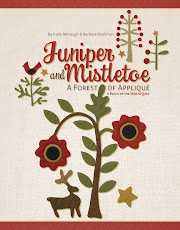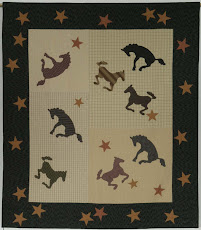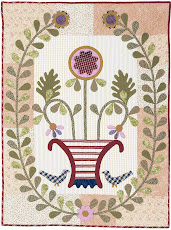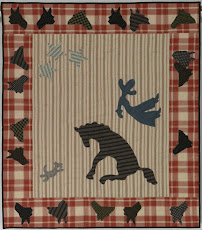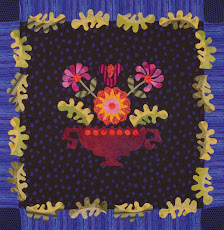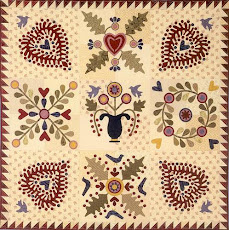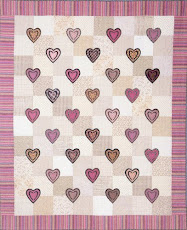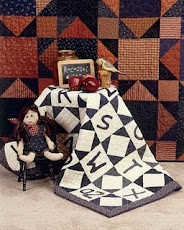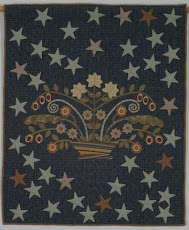I've always thought tessellations are interesting – I love the look of interlocking, repeating geometric shapes. But I had stayed away from making a tessellating quilt because I didn't want to deal with all those odd-sized pieces and the mental stress of keeping the intricate color placement in order.
So I was intrigued a few months ago when my local quilt shop owner, Michelle Klein, showed me all the tessellation projects she was working on. She had made large quilts, mini-quilts, holiday table runners, and all kinds of projects using a new acrylic ruler called the Twister tool.
The ruler comes in 2 sizes, one that starts with 10" fabric squares and one that starts with 5" squares.
Each square is marked with 2 intersecting lines which divide the square into 4 identical odd-shaped pieces. If you cut these 4 pieces out individually, you could place them back together in a pinwheel pattern. And if you cut out a lot of these identical pieces, you could make a pinwheel tessellating quilt. A lot of cutting, and lot of keeping track of fabric placement! But....you don't have to do that. Here's what you do instead:
For a quilt made with the large Twister tool, choose the fabrics for your quilt and cut a 10" square of each. Arrange the blocks in a color pattern that you like, sew them together, then add a 6 1/2" (6" finished) contrasting border. Here's my version, made with a 10" Layer Cake set that Barbara Brackman had given me from her Morris Workshop Fabrics line from Moda.
 Note: Since I was working with a charm pack, I decided to try this shaded color placement. I made a mistake, though, in choosing the border fabric. My border is the same fabric as the square in the lower left corner, and it's the same value as many of my dark squares in the outer rows of the quilt. For contrast, I should have used a border fabric from a square that didn't touch the border. Any of the inner-square fabrics would have worked.
Note: Since I was working with a charm pack, I decided to try this shaded color placement. I made a mistake, though, in choosing the border fabric. My border is the same fabric as the square in the lower left corner, and it's the same value as many of my dark squares in the outer rows of the quilt. For contrast, I should have used a border fabric from a square that didn't touch the border. Any of the inner-square fabrics would have worked.Next, cut this quilt up!! to make the real quilt. Place the Twister tool so that the intersecting lines correspond to the seams in your first quilt. Cut all the way around the ruler. The result will be an 8" square comprising four tessellating segments, each in a different fabric.
 You'll have a small square and a "tail" leftover from each fabric. Save them for another project! For ideas, see Deb Rowden's Thrift Shop Quilts, http://debrowden.blogspot.com
You'll have a small square and a "tail" leftover from each fabric. Save them for another project! For ideas, see Deb Rowden's Thrift Shop Quilts, http://debrowden.blogspot.comAfter you cut, twist each block to the right so that it is straight, and sew the blocks together. Do this in an orderly fashion, so you don't get mixed up. I started at the upper left corner. At first, I cut only 2 or 4 blocks at a time and sewed them together before cutting again. As I gained confidence, I cut whole rows at a time. But I sewed each row together as soon as I cut it. When I finished 2 rows, I sewed them together, then I kept adding each row as I finished it.
The result, a tessellating quilt with a consistent inner border all around! And made from squares with no diagonal seams to sew. (Well, the entire outer edge is on the bias. I almost forgot about that. I sewed a straight stitch all around the quilt to keep it from stretching.) I'm going to add a narrow red border and outer brown border to my quilt. It was a quick and fun project, and I think it has the potential to be a good stash buster. Sometime, I'm going to make a larger, two-color Twister quilt from my stash.
This snap didn't get the entire quilt top, but it does contain a cute back view
of Barbara's daschund, Dottie, who seems to really like quilts.
A side border block, above, will be half border fabric with
2 block segments. A corner block (not shown) will be 3/4
border fabric and 1 block segment. All the inner blocks,
shown below, will contain 4 fabrics.
Here are a couple of links for more information:
First, the publisher of the ruler set, the Country Schoolhouse in Superior, Wisconsin. Their website has some wonderful project photos and they are an on-line source for buying the ruler, too. Note: today's blog is just an unsolicited testimonial; I had nothing to do with the creation or publication of these rulers.
http://www.country-schoolhouse.com/kits/090209/twister_tool.htm
And a great blog on tesselations by Creative Chick sisters Leslie and Emily at http://creativechicksatplay.blogspot.com/2009/02/black-and-white-tessellation-quilt.html
And my local quilt shop, The Gathering Room in LaGrange, Kentucky. If you are in the Louisville area and love reproduction fabrics, this is a great place to shop.











